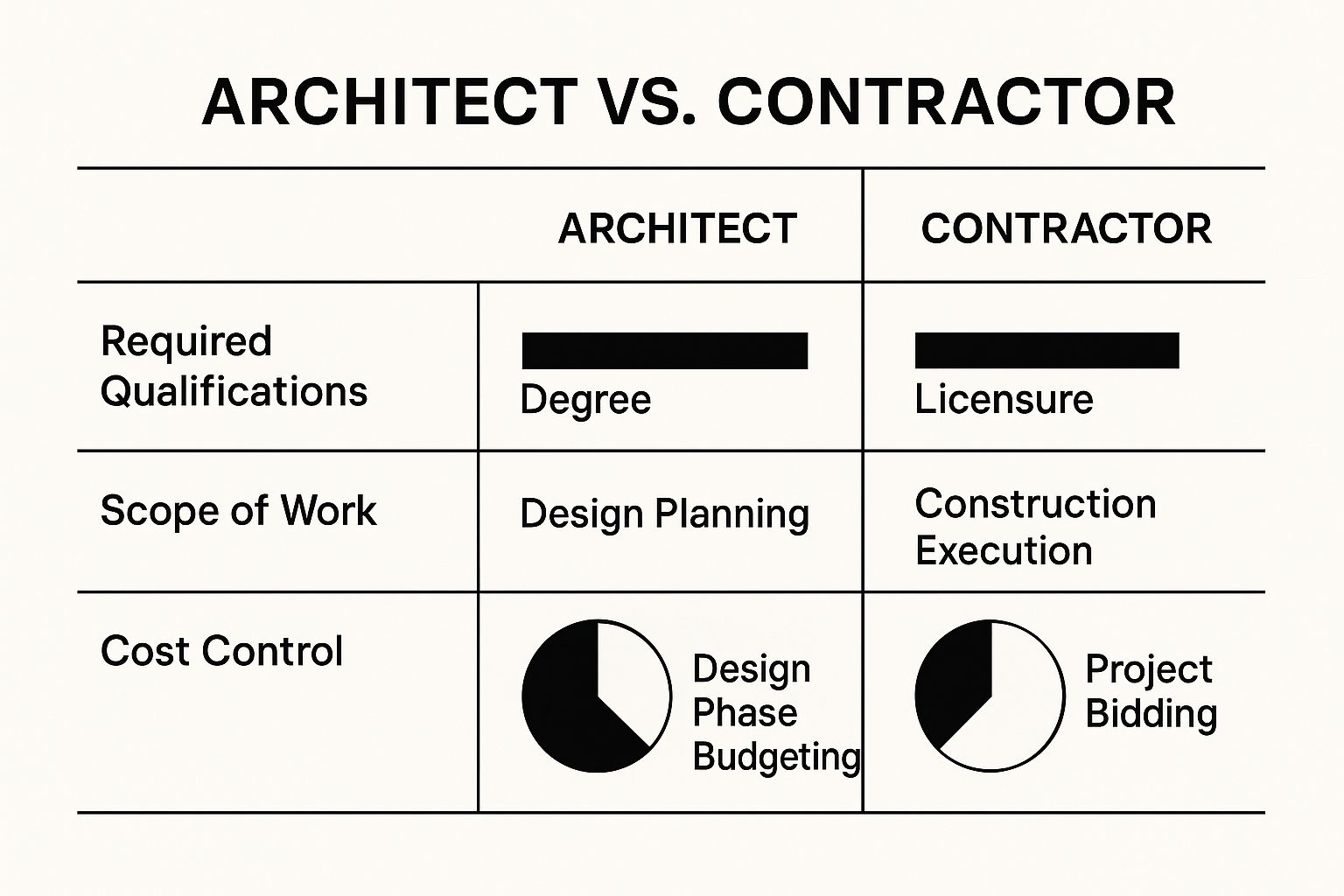When you’re planning a home remodel in Orange County, one of the first and most critical decisions is who to hire: an architect or a contractor. The distinction is crucial. Architects are the visionaries who translate your dreams into a functional, buildable blueprint. Contractors are the master builders who manage the physical construction from start to finish. For affluent homeowners seeking high-end results, the best outcomes almost always involve both, working in harmony.
Architect Vs. Contractor: A Quick Comparison

Understanding the distinct roles in the architect vs. contractor dynamic is the first step toward a successful renovation. Think of it this way: the architect is the project’s creative mind, while the general contractor is its hands-on leader. One creates the “what,” and the other directs the “how,” ensuring your project is a seamless success.
An architect’s expertise lies in design, aesthetics, and ensuring a space flows and functions beautifully for your lifestyle. They are responsible for creating hyper-detailed plans that guarantee your new kitchen, bathroom, or home addition is not only stunning but also fully compliant with the complex local building codes found in cities like Newport Beach or Irvine.
A general contractor, on the other hand, takes those meticulously crafted plans and brings them to life. They are in charge of the entire construction phase—from hiring skilled subcontractors and sourcing high-quality materials to keeping the project on schedule and on budget.
Core Responsibilities at a Glance
To make it even clearer, let’s break down their main responsibilities in a typical home renovation. This table provides a quick snapshot of who does what, helping you see where one’s duties end and the other’s begin.
| Key Aspect | Architect (The Designer) | General Contractor (The Builder) |
|---|---|---|
| Primary Goal | To design a functional, safe, and aesthetically pleasing space that meets client needs and local codes. | To execute the design plans on time and within budget, ensuring quality craftsmanship. |
| Key Deliverable | Detailed construction drawings, blueprints, and specifications. | A completed physical construction or renovation project. |
| Main Focus | Conceptual planning, creative problem-solving, and regulatory compliance. | Project management, logistics, site safety, and subcontractor coordination. |
| Involvement | Primarily involved in the pre-construction phase, with oversight during construction. | Primarily involved during the construction phase, from groundbreaking to final inspection. |
The simplest way to view it: An architect designs your dream on paper, ensuring it’s buildable and legal. A contractor takes that paper and builds your dream in reality, ensuring it’s done with precision and excellence.
As a BBB Torch Award Winner for Ethics, we at Sparkle Restoration Services believe deeply in transparency and homeowner education. Understanding these fundamental differences empowers you to build the right team for your specific project. Whether you need a visionary designer, a master builder, or an integrated design-build firm that combines both, making an informed choice is the key to turning chaos into calm.
The Architect’s Role in Your Renovation

When weighing an architect vs. contractor, it’s helpful to think of the architect as the master planner for your renovation. Their role extends far beyond just sketching floor plans. They are the creative visionaries who ensure your project is beautiful, functional, and structurally sound from the very beginning.
An architect’s first responsibility is to take your vision—all the ideas you’ve imagined for your space—and translate them into a concrete, buildable plan. They begin by studying your property, listening carefully to your goals, and then crafting a design that marries your aesthetic taste with practical needs. This upfront investment in professional design is precisely what prevents expensive mistakes and oversights later on.
For homeowners in Orange County, where building codes and zoning laws can be incredibly complex, an architect is indispensable. They are experts at navigating the maze of permits and regulations, ensuring your project is fully compliant before any construction begins, saving you from potential headaches and liabilities.
From Concept to Construction Documents
An architect’s process is methodical and client-focused. They move from big-picture ideas to the hyper-detailed instructions that a contractor will follow to the letter. This is where their true value emerges, protecting your investment while championing your vision.
Their key responsibilities typically break down like this:
- Schematic Design: This is the creative beginning, where they develop initial concepts, rough sketches, and different layouts to explore what’s possible for the space while respecting your goals.
- Design Development: Here, the chosen design is refined. The architect helps you select materials and finishes, and defines the overall look and feel of your new space.
- Construction Documents: This is the final and most critical step—creating the highly detailed blueprints and technical specifications that a general contractor needs to build the project perfectly.
To get a better sense of this journey, you might find this guide on the stages of architectural design useful. These documents are the essential bridge between your dream and the finished home, leaving zero room for error.
An architect’s most critical function is to be your advocate. They ensure the design not only looks incredible but also serves your lifestyle, adheres to safety standards, and respects your budget.
A Worthwhile Professional Investment
Hiring an architect is an investment in quality and peace of mind. They provide the foundational plan that enables a skilled contractor to execute your project with precision, ensuring the final result lives up to the high standards that discerning Orange County homeowners expect and deserve.
The General Contractor’s Role On The Job Site

If an architect creates the vision, the general contractor (GC) is the on-the-ground commander who brings it to life. In the architect vs contractor dynamic, the GC takes the detailed blueprints and assumes total responsibility for the physical construction, from breaking ground to the final walkthrough.
Their role is a blend of immense logistical skill and hands-on leadership. A top-tier GC, like the IICRC Master Certified team at Sparkle Restoration Services, becomes the central nervous system for your project. They ensure every moving part works in perfect harmony, managing a vast range of tasks to protect your investment and guarantee a quality outcome.
This on-site leadership is what turns a stack of plans into a tangible, beautifully finished space. They are masters of execution, transforming the potential chaos of a job site into a controlled, efficient, and calm process.
Master of Logistics and Execution
A general contractor’s primary job is to orchestrate a complex symphony of people, materials, and specialized trades. They are responsible for building the project exactly as the architect designed it, while adhering to the agreed-upon budget and schedule.
It’s a significant responsibility with many moving parts. Key duties always include:
- Subcontractor Management: Hiring, scheduling, and supervising every skilled trade involved, from electricians and plumbers to painters and flooring installers.
- Material Sourcing: Ordering and managing all necessary construction materials, ensuring they meet the quality standards specified in the design.
- Timeline Adherence: Creating a detailed construction schedule and, more importantly, keeping the project moving forward to finish on time.
- Budget Oversight: Actively managing the project’s finances, tracking all expenses, and ensuring the work stays within the budget.
This hands-on management is vital. A reputable, licensed contractor provides enormous value by ensuring superior craftsmanship and maintaining a safe, organized worksite. They also act as your single point of contact for all construction-related matters, simplifying a complex process and reducing your stress.
For a homeowner, a skilled general contractor is your most important ally during the build. They are the ones solving daily problems, coordinating dozens of people, and ultimately carrying the responsibility for delivering the finished product.
The Importance of Proper Licensing and Insurance
Hiring a licensed and insured general contractor is non-negotiable, especially here in Orange County. A valid contractor’s license is your confirmation that they have met the state’s rigorous standards for experience and knowledge. Crucially, it is what allows them to pull the necessary building permits to keep your project legal.
Working with an unlicensed individual exposes you to serious financial and legal risks. This is even more critical if your project involves an insurance claim from water or fire damage. Navigating that process requires specialized expertise. A professional firm can handle the complexities—you can learn more by reading our homeowners’ guide to property insurance claims.
As an IICRC Master Certified and licensed General Contractor, Sparkle provides the verified expertise that protects your property and gives you complete peace of mind.
Comparing Project Scope, Costs, and Timelines
When you’re planning a remodel in Orange County, a key part of the architect vs. contractor decision comes down to budget and timeline. Getting this right is critical, as it shapes your financial commitment and the project’s final outcome. The two professionals have fundamentally different roles, and understanding how they operate—and charge—is key to a successful project.
Think of it this way: an architect’s work is a strategic, upfront investment in planning and design. A contractor’s costs, on the other hand, are tied directly to the hands-on labor and physical materials needed to build your vision.
An architect’s main job is to create the design intent—the complete blueprint for what your new space will look, feel, and function like. This involves more than just aesthetics; it includes detailed plans, material specifications, and ensuring everything meets local building codes. In contrast, a contractor handles the means and methods of construction. They are the ones who turn those detailed plans into a physical reality, managing the trades, sourcing materials, and getting the job done on site.
Breaking Down the Cost Structures
The way architects and contractors charge for their work reflects their distinct roles. Understanding this financial difference is one of the most important steps for a homeowner before starting a major renovation.
- Architect Fees: An architect typically charges either an hourly rate or a fee based on a percentage of the total construction cost, often falling between 8% and 15%. While this may seem like a significant upfront expense, this investment in meticulous pre-construction planning prevents much more expensive mistakes and changes once construction is underway.
- Contractor Pricing: Contractors usually offer a couple of pricing models. A fixed-price (or lump-sum) contract provides a single, all-in cost for the project. The other common model is a cost-plus contract, where you pay for the actual cost of labor and materials, plus an agreed-upon percentage or fee that covers the contractor’s overhead and profit.
For a more granular look at where the money goes, it helps to understand a detailed construction cost breakdown and how all these pieces fit together.

This table gives a clearer side-by-side view of how these two experts differ in their focus and approach.
Architect vs. Contractor: A Detailed Breakdown
Let’s break down the key differences in a simple table to help you see who does what.
| Criteria | Architect | General Contractor |
|---|---|---|
| Primary Focus | Vision, design, and detailed planning | Execution, management, and physical construction |
| Fee Structure | Percentage of project cost (8-15%) or hourly rate | Fixed price or cost-plus contract |
| Key Deliverable | A full set of construction-ready blueprints | A completed, physically built project |
| When to Hire | At the very beginning, for conceptual design | After the design is finalized and ready to build |
| Main Value | Creative problem-solving and ensuring code compliance | On-site project management and coordinating trades |
Ultimately, this table shows that an architect’s value is in the planning stages—creating a smart, buildable design—while a contractor’s value is in the execution—bringing that design to life efficiently and beautifully.
How Timelines Are Affected
Just as their costs are different, so is their impact on your project’s timeline.
An architect’s heavy lifting happens at the start. This design phase can take several weeks or even months, depending on the project’s complexity. This is not a stage to rush. A hurried design phase almost always leads to delays and budget overruns down the line.
The contractor’s clock starts ticking once the architectural plans are approved and permits are in hand. Their schedule is dedicated to the physical construction sequence—from demolition and framing to the final paint and fixtures. A good general contractor is a master of logistics, creating an efficient schedule that coordinates all subcontractors to keep the job moving and minimize downtime.
Our team at Sparkle excels at managing the complexities of remodeling and construction projects, ensuring they run smoothly from start to finish. We understand how to keep your project on track, turning chaos into calm.
How to Decide Who to Hire for Your Project
Choosing between an architect and a contractor is one of the most important decisions for your Orange County home renovation. This choice sets the tone for the entire project. Get it right, and you’re on track for a smooth, stress-free process; get it wrong, and you could face frustrating delays and budget issues.
The secret is to let the job itself tell you who to call. Your decision should be driven entirely by the scope and complexity of your vision. Both professionals bring critical, distinct skills to the table, and knowing when to engage each is the key to a successful outcome.
When to Hire an Architect First
You’ll want to bring an architect into the conversation from day one if your project involves major changes to your home’s structure or floor plan. In these situations, their expertise in design, spatial planning, and navigating complex permits isn’t just helpful—it’s essential.
You should hire an architect if your project involves:
- Changing the Building’s Footprint: Any time you plan to add a room, build a second story, or change the exterior shape of your home.
- Designing a Custom Home: Building from scratch demands an architect to translate your vision into a detailed, buildable set of blueprints.
- Major Interior Structural Changes: This includes removing load-bearing walls or completely reconfiguring your home’s layout.
- Complex Permitting Needs: Projects in historic districts or areas with strict zoning rules in Orange County often require plans stamped by a licensed architect.
When to Hire a General Contractor Directly
If your project is more cosmetic and doesn’t alter the home’s structure, you can often go straight to a licensed general contractor. This is the common path for renovations where the scope is well-defined and straightforward.
Hire a contractor directly for jobs like:
- Kitchen Cabinet and Countertop Replacement: As long as the existing layout is maintained.
- Bathroom Remodels (No Layout Changes): Simply updating fixtures, tile, and vanities without moving plumbing or walls.
- Flooring Installation or Refinishing: Swapping out old floors for new ones throughout your home.
Even for these projects, due diligence is critical. When you’re hiring a roofing contractor, for example, the same rules apply: verify their licenses, check references, and review their past work. For specific advice on interior projects, our guide on hiring the contractor for a bathroom remodel has the expert details you’ll need.
It’s a common misconception that skilled trades are universally lower-paid than design professionals. Research from the UK has shown that top-tier construction workers, like bricklayers, can earn significantly more than architects, highlighting the immense value and skill involved in high-quality building.
For most significant luxury remodels and additions here in Southern California, the answer isn’t about choosing one over the other—it’s about hiring both. In this ideal scenario, the architect protects the design integrity and provides crucial oversight, while the contractor manages the day-to-day execution on-site.
An even more streamlined approach is the design-build model, which brings both roles together for a truly seamless process from start to finish.
The Advantage of an Integrated Design-Build Firm
The classic debate of architect vs. contractor often frames the process as two separate, sequential steps: hire an architect to create the vision, then find a contractor to build it. While this traditional route can work, it frequently creates a disconnect between the design and the actual construction.
This gap can lead to frustrating problems, such as miscommunication, budget overruns, and extended timelines when a beautiful design proves more complex or expensive to build than anticipated.
This is where the design-build model offers a smarter alternative for homeowners in Orange County. It’s a modern, integrated approach that dissolves the old separation.
A design-build firm brings the entire team—designers, architects, and builders—together under one roof and one contract. From the very first meeting, everyone collaborates. This means every creative idea is immediately vetted against real-world construction costs and practicalities. You have a single point of responsibility, which eliminates the finger-pointing that can derail a project when separate teams have competing agendas.
Seamless Integration from Concept to Completion
For you, the homeowner, the benefits are clear from the start. The entire process is smoother, with one cohesive team managing every detail from the initial sketches to the final walkthrough. This unified structure is perfectly suited for high-end remodels and complex restorations where quality, accountability, and a client-focused experience are non-negotiable.
Here’s what that looks like in practice:
- True Collaboration: Designers and builders are in constant communication, finding innovative, cost-effective solutions in real-time to ensure the final design is both stunning and buildable within your budget.
- Tighter Budget Control: With the construction team involved from day one, cost estimates are far more reliable. This dramatically reduces the risk of expensive surprises once work is underway.
- Faster Timelines: By overlapping the design and construction phases and eliminating the back-and-forth between separate firms, projects are completed more efficiently.
- One Point of Accountability: You have a single, dedicated partner who is responsible for the entire project’s success, ensuring a higher standard of quality and a process focused entirely on your peace of mind.
The real power of the design-build approach is total alignment. When the team dreaming up the design is the exact same team bringing it to life, your vision is protected every step of the way. The result is a flawless execution.
As a licensed General Contractor with deep experience managing complex projects, Sparkle Restoration offers this fully integrated solution. Our approach ensures your vision is executed with precision and efficiency, turning the stressful process of renovation into a calm, controlled, and genuinely rewarding experience. You can learn more about how we work by exploring our design-build services. We don’t just deliver exceptional quality; we deliver the peace of mind that comes from a true partnership.
Ready to transform your Orange County home with a team that values integrity and excellence? Contact Sparkle Restoration Services today to schedule a free consultation and discover how our design-build expertise can bring your vision to life, turning chaos into calm, fast. https://www.sparklerestoration.com

